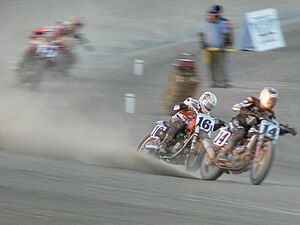
The Harley-Davidson XR-750 is a racing motorcycle made by Harley-Davidson since 1970, primarily for dirt track racing, but also for road racing in the XRTT variant. The XR-750 was designed in response to a 1969 change in AMA Grand National Championship rules that leveled the playing field for makes other than Harley-Davidson, allowing Japanese and British motorcycles to outperform the previously dominant Harley-Davidson KR race bike.[1] The XR-750 went on to win the most races in the history of American Motorcyclist Association (AMA) racing.[2][3][4][5]
The XR-750 is associated with the careers of racers Mark Brelsford, Cal Rayborn, and Jay Springsteen, and was the favorite motorcycle of stunt performer Evel Knievel.[6] Knievel used the bike from December 1970 until his final jump in January 1977. An XR-750 was included in the 1998 The Art of the Motorcycle exhibition, and one of Knievel's bikes is in the Smithsonian's National Museum of American History America on the Move exhibit.[1][7]
- ^ a b Leffingwell, Randy; Guggenheim Museum Staff (1998), Krens, Thomas; Drutt, Matthew (eds.), The Art of the Motorcycle, Harry N. Abrams, p. 319, ISBN 0-8109-6912-2
- ^ Gingerelli, Dain; Everitt, Charles; Michels, James Manning (2011), 365 Motorcycles You Must Ride, MBI Publishing Company, p. 106, ISBN 978-0-7603-3474-4,
Most successful race bike of all time.
- ^ Girdler, Allan; Dewhurst, David (2004), The Harley Davidson Sportster, MotorBooks International, ISBN 978-0-7603-1615-3, retrieved 2011-07-08
- ^ Saunders, Andy (19 March 1996), "Bartels' XLR 1200; Mile racer for the street", Motorcycle.com, retrieved 2011-07-08
- ^ "Europe's riders get their own legendary Harley", Bristol Evening Post, Bristol, England, p. 46, 19 June 2008,
...the legendary Harley-Davidson XR 750 TM flat track racer - a no-nonsense, purpose-built race bike that has notched up more wins than any other racing bike in the history of the sport, this bike does not disappoint.
- ^ Barker, Stuart (2008), "Major Career Statistics", Life of Evel: Evel Knievel, Macmillan, pp. 279–300, ISBN 9780312547356
- ^
- "America on the Move | Evel Knievel jacket and motorcycle". National Museum of American History. 2008-10-24. Retrieved 2009-08-14.
- Evel Knievel's Harley-Davidson XR-750, National Museum of American History, retrieved 2011-07-10